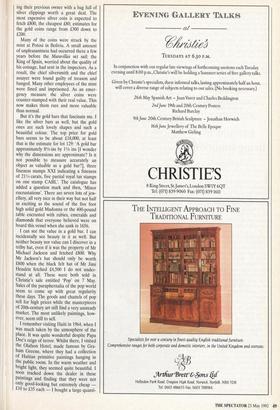Sale-rooms 2
Well chewed
Alistair McAlpine
On 28 May, Christie's have a sale of Spanish art, 'Treasure from the Maravillas and other Works of Art'. Forget the other works of art: it is the treasure that matters. I have always been fascinated by treasure recovered from the sea and so it seems has the public, at least that part of it that attend auctions. For a chewed-up coin sold as part of the contents of a wreck will always fetch considerably more money than the same coin bought from the gentlemen under the arches of Charing Cross who sell these objects.
There are a great number of coins in this sale, and most of them have been quite well chewed. This chewing comes from the habit at the time of cutting the smallest pieces off a great many coins, not affecting the value when they are passed on but leav- ing their previous owner with a bag full of silver clippings worth a great deal. The most expensive silver coin is expected to fetch £800, the cheapest £80; estimates for the gold coins range from £300 down to £200.
Many of the coins were struck by the mint at Potosi in Bolivia. A small amount of unpleasantness had occurred there a few years before the Maravillas set sail: the King of Spain, worried about the quality of his coinage, had sent in the inspectors. As a result, the chief silversmith and the chief assayer were found guilty of treason and hanged. Many other employees of the mint were fined and imprisoned. As an emer- gency measure the silver coins were counter-stamped with their real value. This now makes them rare and more valuable than normal.
But it's the gold bars that fascinate me. 1 like the silver bars as well, but the gold ones are such lovely shapes and such a beautiful colour. The top price for gold bars seems to be about £18,000, at least that is the estimate for lot 129: `A gold bar approximately 85/s ins by 13/s ins [I wonder why the dimensions are approximate? Is it not possible to measure accurately an object as valuible as a gold bar?], three fineness stamps XXI indicating a fineness of 211/4 carats, five partial royal tax stamps on one stamp CABL'. The catalogue has added a question mark and then, `Minor encrustations'. There are seven lots of jew- ellery, all very nice in their way but not half as exciting as the sound of the five foot high solid gold Madonna or the 400-pound table encrusted with rubies, emeralds and diamonds that everyone believed were on board this vessel when she sank in 1656.
I can see the value in a gold bar. I can incidentally see beauty in it as well. But neither beauty nor value can I discover in a trilby hat, even if it was the property of Mr Michael Jackson and fetched £800. Why Mr Jackson's hat should only be worth £800 when the black felt hat of Mr Jimi Hendrix fetched £4,500 I do not under- stand at all. These were both sold in Christie's sale entitled `Pop' on 7 May. Sales of the paraphernalia of the pop world seem to come up with great regularity these days. The goods and chattels of pop sell for high prices while the masterpieces of 20th-century art still find a very unsteady market. The most unlikely paintings, how- ever, seem still to sell.
I remember visiting Haiti in 1964, when I was much taken by the atmosphere of the place. It was quite wonderful despite Papa Doc's reign of terror. Whilst there, I visited the Olafson Hotel, made famous by Gra- ham Greene, where they had a collection of Haitian primitive paintings hanging in the public room. In the warm weather and bright light, they seemed quite beautiful. I soon tracked down the dealer in these paintings and finding that they were not only good-looking but extremely cheap £10 to £35 each — I bought a large quanti- ty. Amongst them were two paintings by Hector Hyppolite.
I was interested, therefore, to find from the catalogue of a Christie's sale in New York of 'Haitian Paintings and Sculpture' that this gentleman's work now fetches around $60,000. Work by his less famous colleagues seems to fetch from about $1,000 to nearly that figure. Needless to say, I tired of my Haitian paintings many years ago and disposed of them, for the very good reason, when I think about it, that the paintings were extremely bad.




































































 Previous page
Previous page